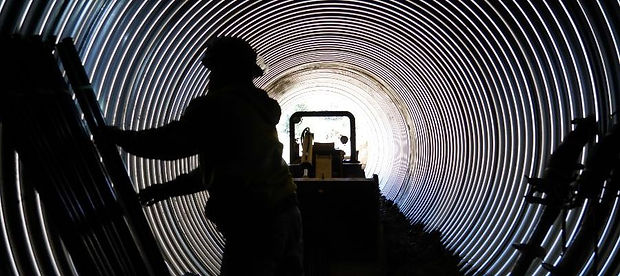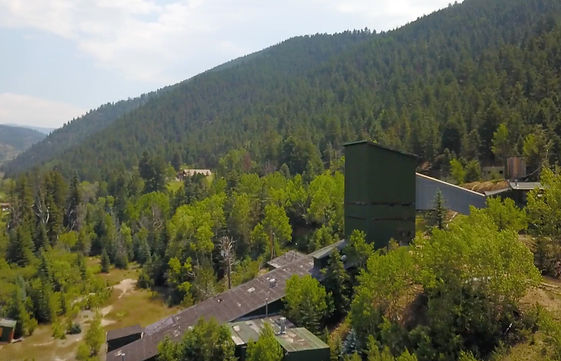Listen to GS Mining CEO on the Stanford Business Podcast, "The Innovators." -- CLICK HERE

We've Reopened the Richest Square Mile on Earth
GS Mining Company is assembling and operating a world class portfolio of gold mining assets in the Central City/Black Hawk region of Colorado. It was there that gold was discovered in 1859. By 1900 the area was dotted with small mines, and National Geographic referred to it as “the richest square mile on earth.” Recent studies estimate that only fifteen percent of the existing gold was ever extracted. GS Mining’s mission is to acquire, rehabilitate, and operate these old mining properties with new techniques and sustainable practices, all directed to recovering that eighty-five percent the “old timers” left behind.
This is the remarkable story of the trailblazers behind the rebirth of the Bates Hunter Mine. With at least 85% of the gold in Central City, Colorado left undiscovered, GS Mining Company is leading the revival that is 160 years in the making.
Come join us for a look at the Bates Hunter Mine revival and so much more.

Bates Hunter Gold Mine
The Bates Hunter Gold Mine consists of a series of proven gold veins.link The operation is fully permitted, holding a section 110(2) permit for mining and milling operations and includes an EPA approved water treatment facility. Expert analysis, including a 43-101 of the mine shows a potential for significant gold recovery that may be between one and three million ounces. There is an approximate eight-hundred-foot shaft in place, and there are no records of any production from its lower depths. Current assay reports detail multiple ounces per ton readings. Other area mines have extended recovery to 2200 feet. Reports of the Bates Hunter mine indicate substantial gold resources at lower depths. The mine is currently served by infrastructure that would cost approximately $40 million dollars to replicate today. It has an elevator system that can service the entire "main"; shaft of approximately 800 feet. It has its own mill that can service the tons of "rock"; that will be removed and processed to be sent to a smelter. It has an EPA water purification system.
The Bates Hunter and Becker Bates Mines have been connected at the five hundred foot level. Assays from the area of the connection have produced some of the highest opt gold readings to date indicating the presence of multiple ounces per ton.

The Becker Bates Mine
The Becker Bates Mine is a historic mine whose workings date back to the Colorado gold rush. There is an existing shaft which has been rehabilitated and connected to a tunnel coming from the Bates Hunter at the 500-foot level. This connection between the two mines is of significant value to the Company as it represents a continuation of veins emanating from the Bates, including the Bates vein. The Becker Bates adds 839 feet to the 2,953 feet of rich vein at the Bates Hunter. Core drilling found that the Bates vein extends to depths of 1100 feet demonstrating mineralization throughout the property extending well below the current shaft.
Although no current reports on the Becker are known to exist, (other than current assays and samplings), the 1934 Shotwell Report refers to the Bates and the Becker as the “cream of the (mining) district” and, in discussing the connection between the two shafts notes, “wide and rich shoots at the junction of the two (with) plenty of ore left.” There has been no commercial mining at either site since this report was written and management believes that whatever was detected in 1934 is still there. The Gregory vein, one of the richest gold bearing veins in the area, runs through both the Bates and the Becker. According to Shotwell, “This vein has always been considered one of the strongest and best veins …(and) the best place in the state to quickly and surely make a big mining success.” A report from Fred Jones, E.M. issued at about the same time described “three shoots of ore opened on the mine” with many multiple-ounce-per ton assays.

The Gregory Bates
The Gregory Bates are all historic claims without any commercial mining activity in recent history. These claims can all be accessed underground from the Bates Hunter and like the Bates Hunter many of the claims have rich histories and huge potential Two of the mines, the Foot & Simmons” and the John Gregory discovered gold in this area in 1859. It was then called Mountain City and the Bates was right in the middle of that City. There were several other particularly rich diggings in that neighborhood including the “Foot and Simmons” and the “Peck and Thomas”. Those two claims were only mined to depths of 200 feet.
The Simmons lode was referenced in the 1865 American Mining Gazette & Geological Magazine: “The Simmons lode although not as wide as Gregory appears more rich.” Also, at that time, Harvard Professor William Dalton, who was studying gold in what was then called Mountain City, now Central City, described the veins and mines as comprising, “… a large and steady supply of ore may be obtained for a century to come…
I know of no mines containing better prospects.”
We are excited about the potential of these new properties. By name they are Mosell, Next President, Simmons, Whiteside, Hope, Dump, Foot & Simmons, Branch, New Lode, Peck &Thomas, and Jean (as well as several without names). In 1865 Professor Dalton predicted a hundred years’ worth of gold. By 1900 work had stopped on all those claims. If he was right, we’ve still got sixty-five years to go. We intend to go!

The Clay County Mine
The Clay consists of approximately 18 acres above ground. The Clay is a historic mine whose workings date back to the Colorado Gold Rush. Unlike the Bates Hunter, the Clay is not served by a vertical shaft but rather by a series of inclines/declines that have direct access from a mine portal on the property. The inclines/declines connect with tunnels and shafts reaching over four hundred feet below grade. Because the mine drains into the national tunnel, this mine, unlike the Bates Hunter, requires no pumping or water treatment.
There is no current geologic reporting on the Clay which has been out of operation for decades. There were studies conducted in 1979 by a firm that was investigating restarting the mine. Although not a 43-101 which didn’t exist until the 1990s, there was a geologic study that determined inferred gold reserves of 103,933 ounces worth about $185 million dollars at current rates and depth. In this area other mines have successfully extracted ore from depths of over 2000 feet.

The Carr Mine
The rights to the Carr Mine ("Carr") were included in the acquisition of the Bates Hunter Mine and is a separate gold bearing vein known as the Carr Vein.
The Carr was worked from 1893 to 1910 and like the Bates Hunter has had no commercial mining in over 100 years.
The U.S. Geologic Report notes that the Carr vein contained gold ore that was assayed at .72 to 9.06 ounces per ton. These are remarkably promising results. The Company intends to begin exploration of this vein after its current focus on the Bates Hunter rehabilitation is concluded. Based upon the historic data, the Company believes that like the Bates Hunter, there will be substantial gold that remains untouched in the Carr.

The Golden Gilpin Mill
The Golden Gilpin Mill has been a milling site since the 1860’s. It is in Black Hawk, literally around the corner from the Bates Hunter and has easy access from the main road. Over a hundred years ago Black Hawk was known as the City of Mills with thirty in operation. The Golden Gilpin is now the only mill remaining in town. Central City was once called the City of Mines. We are now the only licensed mine in the City.
The Company acquired the rights to the Mill in the same transaction that added the Bates Hunter Mine and the Carr Mine to its growing portfolio. When the Company finishes rehabilitating the 1932 Mill building, it will be able to process seventy tons of ore per day.
After extensive rehabilitation and renovation, the mill is in daily operation turning out both free gold and flotation concentrate. The mill is currently in Phase I with the goal of processing approximately 28 tons a day. Phase II will lift production to 75-90 daily tons. When the Black Eagle is completed, total milling volume will be in the range of 200-220 tons per day.

The Black Eagle Mill
In April 2021 the Company acquired the Black Eagle Mill. It is In Idaho Springs about 20 minutes away from the Bates Hunter. Idaho Springs was part of the Colorado Gold Rush and the Mill operated until the 1980s. Like the Golden Gilpin the Mill needs substantial rehab and renovation. When that work is completed, the Mill should add about 125 tons per day capacity to the entire operation. This means that total daily production will be approximately 200 tons per day.








